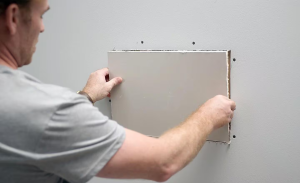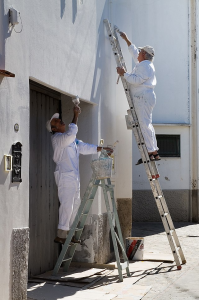Pressure washing, also known as power washing is the use of pressurized water to remove loose paint, mold, grime, dust, mud, and dirt. This process is effective for cleaning surfaces and objects of both residential and commercial properties.

Detergents can help improve the performance of pressure washers by lowering surface tension and emulsifying oils. They can also enhance the removal of dirt and other contaminants that are otherwise unaffected by pressure washing alone. Visit https://summervillepressurewashing.com/ to learn more.
Pressure washing is a necessary part of home maintenance, but it can be dangerous if done incorrectly. Many people avoid using this method because they think it is harsh and damages surfaces, but professional contractors use the right equipment, technique, and pressure settings to ensure that your property is not damaged. Whether you need to remove dirt, mud, mildew, or moss from your driveway, sidewalk, patio, or other outdoor surface, pressure washing is an effective way to quickly and easily clean it without damaging the material.
Dirt, moss, and grime can eat away at surfaces like vinyl siding, wood decks, and concrete, causing damage and exposing your property to moisture and vermin. Regularly cleaning these materials and surface coatings with a power washer helps prevent this, keeping your building or outdoor surfaces looking fresh and new.
Similarly, pressure washing your commercial building’s exterior regularly prevents the build-up of contaminants that can shorten its lifespan and cause costly repairs later on. A clean, well-maintained building is more appealing to customers and clients and can help you attract and retain business.
In addition to avoiding damage to your property, regular pressure washing can help you prevent health problems caused by dirt and grit. Mold, mildew, and moss build-up not only stain surfaces and make them look dirty and unkempt, but they also contain harmful bacteria that can spread to your indoor spaces if not removed with regular cleaning. Pressure washing can help to eliminate these spores before they spread, protecting your family or employees’ health and safety.
Having your windows professionally washed with the right pressure setting prevents the risk of damage while giving them a thorough, deep cleaning that you can’t get with normal water or household cleaners. Be sure to avoid over-washing your windows, and only use high pressure for hard-to-clean spots, such as greasy or oily stains. Also, be sure to rinse the window seals and badges before turning off the nozzle and standing back at least six feet. You can further protect your windows by only using a cold water pressure wash and by washing from the bottom of the window up to the top.
Prevents Disease
Using a high-powered water spray, pressure washing removes grime, moss, mold, mildew, loose paint, oily stains, and other substances from exterior surfaces like brick, concrete, wood, vinyl siding, decking, windows, driveways, roofs, and more. A professional pressure washer uses a wide range of attachments to control the force and width of the spray. When used correctly, hot water pressure washing reduces the need for chemical disinfectants that may be harmful to the environment or cause health problems for those who come into direct contact with them.
Dirt and debris build-up provides the perfect breeding ground for bacteria and vermin, who are notorious for carrying disease and leaving buildings vulnerable to spores that can cause illness. Regular cleaning with a professional pressure washer reduces these risks and helps to keep occupants safe.
Furthermore, the hot water used in pressure washing significantly decreases surface tension and seeps into crevices, allowing it to penetrate dirt, grease, and other contaminants that are difficult to reach with conventional cleaning methods. This allows for a more thorough clean that eliminates dangerous microorganisms and other pathogens, making it an ideal sanitation method.
The hot water pressure washing method also has additional ecological advantages that make it a more environmentally sustainable option than other cleaning methods. By reducing the need for chemical cleaners, this method cuts down on pollution to waterways and municipal drains. It also minimizes the amount of chemicals that are released directly into the environment, ensuring that local flora and fauna remain unharmed.
Pressure washing also helps prevent the deterioration of building components, preventing them from becoming damaged by water damage and avoiding costly repairs in the future. It can also help to spot any potential issues that may arise, such as roof leaks or structural problems with the foundation, giving homeowners the opportunity to address them sooner rather than later. A routine schedule of professional pressure washing acts as a preventative maintenance measure, staving off expensive repair bills and preserving the value of the property. This is especially helpful for those considering renovations or selling the home in the future as it can greatly enhance curb appeal and prepare the property adequately for any potential buyers.
Prevents Allergies
Pressure washing removes allergens and improves air quality to help ease allergy symptoms. Outdoor allergens such as pollen, mold and dust cling to surfaces and become airborne, irritating and worsening allergies and asthma. In addition, these substances can be tracked inside, worsening indoor air quality. Regular cleaning with a pressure washer, along with indoor air conditioning maintenance and HEPA filters, can significantly reduce allergy-related problems.
Allergens accumulate on exterior surfaces including walls, decks and patios, but can also be found in shady or damp areas where mildew and mold thrive. The powerful force of the water quickly dislodges these and other allergens, preventing them from becoming airborne or settling on indoor surfaces. The process is especially effective for textured surfaces, as well as hard-to-reach areas like gutters and driveways. In addition, a professional service will use environmentally friendly cleaning solutions that won’t damage plants or surfaces.
When performed correctly, a pressure wash eliminates the source of most allergy issues. The right timing is critical — spring and fall are best before and after peak allergy season when pollens like ragweed and grass are most prolific. Regular, annual cleaning with a pressure washer limits allergen buildup and keeps surfaces clean.
In addition to regular cleanings, homeowners can limit the amount of time they spend outdoors during high pollen counts and take other precautionary measures like closing windows and using screens or a filtered mask. Sealing cracks, crevices and gaps in the home’s exterior and removing pet hair and dander from outdoor spaces will also minimize allergy-causing substances from entering the home.
When allergens are removed from outdoor surfaces, indoor air quality improves as well, boosting productivity and overall health. For optimal allergy relief, combine pressure washing with other prevention strategies, such as sealing cracks and using weather stripping to keep allergens from entering the home and utilizing HEPA air filters in HVAC systems and vents. With these strategies in place, you can bid adieu to allergies, allowing you and your family to enjoy a happier and healthier living environment.
Increases Value
Curb appeal is one of the most important factors in increasing the value of a property. A clean exterior gives a positive first impression, reassuring prospective buyers or tenants that the property has been well-maintained and cared for. It also helps prevent potential damage from environmental factors like dirt, mold, mildew, and fungus. Having the exterior of your home, office building, or business regularly pressure washed is an effective way to preserve surfaces and increase curb appeal.
A professional pressure washing company can provide a deep clean of outdoor spaces, eliminating unsightly stains and promoting an overall better aesthetic for your property. They are also able to reach areas that are inaccessible with other cleaning methods, such as hard-to-reach crevices. Additionally, they can prepare surfaces for resurfacing or painting by removing contaminants that may interfere with adhesion.
Whether you are looking to sell your home or simply want to improve its curb appeal, regular pressure washing is an affordable way to increase your property’s value. Studies show that homes with great curb appeal sell 7% faster and for 5-10% more than those that are not as appealing. This is because a well-maintained exterior gives the impression that the property is in good condition, reducing buyer anxiety about future expenses and maintenance costs.
However, it is crucial to note that improper pressure washing can damage or kill plants and cause costly repairs. This is because high-pressure water can strip away mulch layers, disturb the delicate ecosystem that supports plant roots, and damage or uproot tender foliage. As such, it is crucial to hire a professional to perform power washing services and ensure that the right settings are used to avoid any unnecessary harm.








